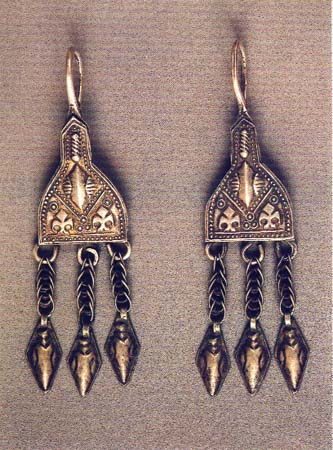
Sometimes Kazakh boys wore earrings
Those parents who lived long without sons believed that an earring could protect a boy from hexes, evil forces and illnesses. Kazakh boys wore this earring until the age of five, and the Uzbeks — until their marriage. Every Uzbek family organised a special party and removed it. The Kazakhs called this party syrga toi. This tradition was observed until the early 20th century. There were rare cases in the 1940-50s.

Father’s favourite daughters had nose rings
According to the researcher Andreev, some Kazakh women had small nose rings marking that they were favourite daughters of their fathers. Thus, the Kazakhs had a tradition to wear nose rings.

Earring was believed to protect from gossips and evil words
People believed that earrings could protect from negative energy, evil words and gossips. Sometimes while discussing something with others a woman could say her minor children: "put on golden earrings" meaning "don’t listen to unnecessary information and remember what is important".
Earrings also served as a symbol a woman’s authority. The size of jewellery showed the wealth, age and origin of their owner. Women in Central Asia believed that the bigger earrings the more expensive and beautiful they were that accordingly empowered her status. Very often women put on the biggest silver earrings.

Earrings prepared women for becoming mothers
Earrings affect the formation of girl’s beauty and improving her character. It is believed that this kind of jewellery is the key for having many children in future. Earrings of a girl who was at the age of marriage depicted the Sun and Luna, and pendants had images of grain, seeds and leaves showing that she was ready to become a mother. All the images hinted that she could give birth to many children.
There are some traditions that we cannot understand
The Kazakhs put off jewellery from the body of a dead woman. But they leave rings in her ears. People believe that if a woman doesn’t have earrings, a snake will enter her ears. If a dead woman didn’t wear earrings in the lifetime, her ears had to be pierced.
According to historical chronicles, Turkic women injured themselves when mourning their husbands killed in battles. That was the strict rule for Kazakh and Kyrgyz widows to do so up to the early 20th century. There is a picture in a temple in Panjakent (Tajikistan) depicting the moment when people cut off their ears while mourning the dead. Many peoples in the world have the same rites.

The secret of an earring pinned to a carpet on a wall in yurt
According to ethnographers, many Turkic nations used to pierce ears and put on earrings at early ages. In the past, if a girl wasn’t engaged, her earrings were pinned to walls, carpet or even a stick that holds shanyrak (the upper dome-like part of a yurt). So, every visitor and guest could see that a girl who lived there didn’t have a groom.
People called a bride "syrgaly" (a girl who put on earrings)
The Kazakhs have the ceremony "syrga salu", "syrga tagu" (meaning "to put on earrings" in Kazakh), when the relatives of groom offer earrings to his bride. The family of the bride organises a special party on this day.

Entrants also felt the "magic" of earrings
P. Pallas, an academician of jewellery art, wrote in his work "Trip to Different Provinces of the Russian Empire" (1776): "... there are both smiths and jewellers among the Kazakhs."
Savva Bolshoi who was a prisoner of the Kazakhs in 1803-1804 noted: "There are special craftsmen among Kazakhs who work with gold". He is the author of the collection "The Overview of Akmola region in 1904″ published before the Russian revolution.
A. Geins who lived in the western part of Aktyube region wrote in his "Literary Collection" that the Kazakhs placed silver to a clay bowl and melted it with heated coal.
In the past, the Kazakhs believed that women should wear seal rings or rings on their fingers. If they didn’t, everything she cooked was considered to be evil food. On the contrary, people drank the beverages prepared by a woman wearing a silver ring with great pleasure.
By Gulzhanat ABDIMOMYNOVA
